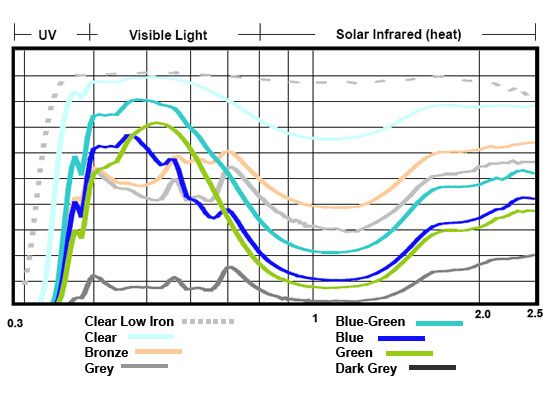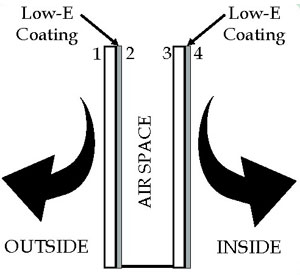Glass Options for Enhanced Building Design
Design Issues and Glass Solutions
With a basic understanding of different manufactured glass types, we can now turn our attention to particular issues that are commonly addressed in building designs to determine the best type of glass that may be suitable solutions.
Controlling Solar Gains
A great deal of the increasing emphasis on energy use in buildings has been placed on the building envelope and particularly on glass and glazing. With the increasing sensitivity toward reducing fossil fuel usage in particular, energy codes and standards have been becoming more demanding in terms of the performance of glazing. They have steadily been raising the bar on performance such that glazing needs to be carefully addressed during design and appropriately specified to both anticipate and achieve the intended energy performance.
The first and perhaps most significant point about energy performance when it comes to glazing is that the building location and the orientation of the glass in respect to the sun (i.e., solar orientation) are the starting points. There is no single universal solution across all locations and all orientations. Energy codes and ASHRAE Standard 90.1 recognize this fact by identifying and defining separate U.S. climate zones which are the basis for determining all other aspects of energy performance and code compliance. From there, the codes require varying degrees thermal performance or solar control depending on location and orientation.
Many commercial buildings are located in warm or temperate climate zones with internal operations that generate heat inside the building (i.e., internal heat loads). Hence, more energy may be needed to cool the building than to heat it in a typical year. Controlling the amount of heat that comes through glass in these cases becomes the dominant design issue then. It should be recognized that heat travels through glass both from the sun’s direct radiation and from the transfer of heat from the ambient exterior environment. Therefore, selecting glass that provides solar control to address both the sunlight and ambient heat reflectance will maximize performance.
Glass can provide direct solar control by one of two fundamental choices. First, it can absorb a portion of the solar energy striking it through the use of absorptive colored tints or absorbing coatings added to the glass. This significantly reduces solar heat and UV light transmittance as compared to clear glass products. Tints add color to the look of the building and reduce the visible light transmittance (VLT) through the glass, all of which are variable based on the degree of tinting and color selected. The key to selecting tinted glass is finding the balance to achieve solar control, help control glare and contribute to the aesthetics of the building. Tinted glass is readily available in a variety of thicknesses (generally between 1/8 inch and 1/2 inch) and can be processed and fabricated similarly to normal float glass making it a convenient way to reduce solar gain. Tinted glass features a full range of color choices such as green, blue, blue-green, bronze, and grey colors. They commonly provide low external and internal reflectance meaning that they are not very mirror-like. They can be laminated, strengthened, and even bent using standard techniques. Further, they can be used singly or in combination with other glazing in insulating glass units. All of these traits have made tinted glass a common solar control choice in low, mid, and high rise office buildings, medical / hospital buildings, educational / school buildings and retail locations.

Image courtesy of Pilkington North America
The chart depicts the percentage transmittance of typical glass types and colors. It demonstrates how tinted glass lowers SHGC through a reduction in transmittance in the Solar Infrared region, while maintaining high light transmittance in the Visible Light region.
Instead of absorbing energy, the other choice of achieving solar control with glass is to reflect it back varying degrees of solar light or heat energy (or both) by applying various coatings during manufacturing. The types and effectiveness of the coating can vary notably between glass products and between manufacturers so it is important to review the technical data to be sure that a coating is selected appropriate to the building, its location, and solar orientation. For example, a coating that produces a low SHGC value will result in very little solar heat passing through the glass while a low-e coating reduces the emissivity of glass and lowers the U-factor. Some manufacturers have coatings that will achieve both solar control and low emissivity and those should be looked at for suitability. Coated glass is available in some fairly clear versions or in a full range of colors including green, blue, blue-green, bronze, gold, and grey. The coatings also commonly reduce UV light transmittance which means fading is reduced in fabrics, artwork, etc. Coatings have been recognized as an ideal means to achieve a rather precise level of solar control for new commercial construction or renovation projects. Specifically by using different coatings on different layers of a dual pane insulated glass unit, the options and possibilities increase for balancing heat gain against light transmittance and U-factors. Hence, coated glass has been commonly used in commercial buildings requiring solar and thermal control such as low, mid and hi-rise buildings, medical/ hospital buildings, educational/ school facilities, office buildings, retail establishments, and residential structures of all types.
Controlling Heat Loss
Turning to colder climates, the approach to thermal energy performance with glass is different. In these locations, the energy required for heating is greater than for cooling over the course of the year. Hence, there is usually a desire to allow sunlight to freely penetrate into the building during the heating season to take advantage of passive solar gains. This means selecting glass with a higher SHGC may be desirable, particularly on sun facing facades. At the same time, low emissivity is desired to redirect energy (i.e., interior room heat) back into a building (rather than out of it), to achieve much lower heat loss than ordinary float glass. For such buildings, this coating is often selected to allow for enhanced clarity and light transmittance which will tend to favor a pyrolytic surface coating over a sputter coating. Once again, the use of different coatings on different layers of insulated glass units allows for some fine tuning of the glazing to suit particular circumstances of different buildings, different solar orientations and different performance needs. The surfaces of insulated glass units are identified by number such that in a typical double pane unit, surface #1 faces the building exterior, #2 is the inner face of the outer pane (in the space between the glass layers), #3 is the exterior face of the inner pane (also in the space between glass layers), and #4 faces the building interior. Usually the coatings are placed on surfaces #2 and #3 so they are not exposed.

Image courtesy of Pilkington North America
Use of a low-e coating on surface #4 in combination with a low-e coating on surface #2 provides a significant reduction in U-factor of approximately 20 percent.
Low-e 4th surface technology
In order to improve the energy efficiency of insulated glass units without increasing the thickness or weight of the window, at least one manufacturer has developed a coating for the 4th surface of the double glazed unit. This 4th surface coating works in combination with a low-e coating on surface #2 to create a significant reduction in U-factor of approximately 20 percent. Pyrolytic Low-E coatings are well suited for this purpose as they provide the advantage of being very durable and difficult to damage, with a track record of use in these types of application for well over 10 years.
Daylighting and Views
In some cases, the visual performance of the glass may be the overriding design issue. This can be true in buildings where daylighting is being used to turn off electric lights and save energy or in cases where the ability to view through the glass with clarity and good color rendition is important. Note that all of the glass discussed for thermal energy performance provides some degree of visual performance and the glass described in this section provides some degree of thermal performance. The distinction is the degree to which the two are balanced or weighted to favor one over the other due to its specific location in a specific building.
Among the things to take into account in selecting glass for daylighting is the quality and quantity of the light that will end up in the interior space. The color of the glass or the coating can affect the color of the transmitted light while clear glass will allow for more accurate color renditions. However, clear glass can be a source of glare. If the glass is not shaded, does not face away from the sun, or is not treated to reduce glare, then the shear light intensity or the high contrast between it and the other interior spaces can create disturbing and unwanted bright light. In that case people will often respond by closing blinds or otherwise block the daylight undoing the intended benefit of the design. Selecting a tinted or coated glass therefore that appropriately addresses glare while still keeping the color clear may be an optimal solution in some cases.

Photo courtesy of Pilkington North America
Quality and quantity of light are important considerations for what type of glass to use when designing a space.
In addition to letting daylight into buildings, allowing people to view out without undue color or view quality issues is also a common design requirement. Clear glass is available that offers excellent optical properties, transmitting up to 90 percent of the sun’s visible spectrum thus maintaining high clarity and low distortion with brilliant flat surfaces. It is available in a wide range of sizes and thicknesses for optimum utilization and is applicable in commercial, residential, and institutional buildings of all types.









